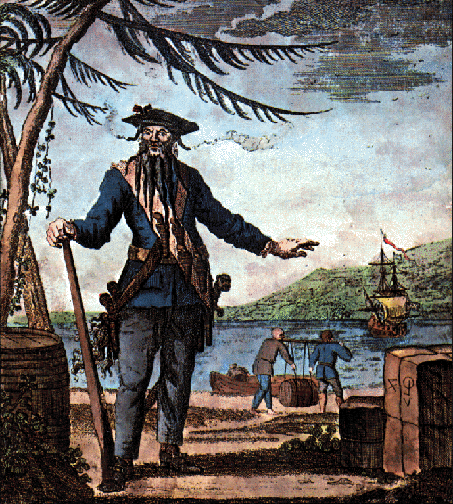Blackbeard and Piracy

Traveling by ship between England and the American colonies was often treacherous due to bad weather, especially a winter crossing when the Atlantic storms were fierce with high winds. In addition, if there were no suitable winds for sailing, the ships simply sat at harbor in England or in the colonies until favorable winds came. As if the vagaries of nature weren't danger enough, the presence of pirates and privateers near to and within the Capes of the Virginia colony made travel ever more treacherous.
In 1710, the year of Lt. Governor Alexander Spotswood's arrival in the Virginia colony, numerous merchant ships were taken over by pirates and privateers. Also, at times, the privateers went ashore and plundered homes carrying off not only goods but owners and slaves as well. Often pirates and privateers sailed with impunity well up into Chesapeake Bay in order to take ships riding at anchor. Without protection from the Royal Navy or ships provisioned by the colonial government, there was little the merchant ships could do.
During King William's War (1689-1697) and Queen Anne's War (1702-1713), the number of pirates operating in the Chesapeake decreased dramatically with a corresponding increase in the number of privateers. When peace returned, the number of pirates increased greatly with a corresponding decrease in the number of privateers. Thus during war time, the pirates became privateers with license to take and plunder enemy ships. The same pirates, during peacetime, returned to their illegal ways and preyed on ships from any country.
As the new Lt. Governor of the Virginia colony, Spotswood wrote to London in August, 1711, that since the departure of the HMS Enterprise for New York, enemy privateers had taken many vessels and had kept the residents of the coastal counties in a constant state of alarm. He requested that a station for refitting and resupplying guard ships be placed at Point Comfort to eliminate guardships having to leave the Chesapeake area for essential services. He further requested a large man of war to protect the Chesapeake and a small "customs" sloop for travel on the James River. The James River area was known for illicit trade with Curaçao and St. Thomas.
Spotswood continued to send requests to London for a large ship to guard the Chesapeake which were denied. The pirates continued to take ships off the Virginia Capes. The year 1718 brought some success fighting pirates with the capture and killing of Edward Teach, AKA Blackbeard, in November of that year by Lt. Robert Maynard. A brief respite from pirate attacks ended with the capture of several merchant ships in 1719. Spotswood responded in 1721 by having 54 guns mounted at the mouths of the York, James and Rappahannock Rivers to protect the anchorages at the mouths of those rivers.
As a result of Spotswood's developing coastal defenses, securing more naval support and dispatching the ships whose men captured and killed Blackbeard, Virginia acquired the reputation as an unfriendly place for pirates. When Spotswood returned to England in 1724, he traveled to New York in order to travel on a naval ship because a number of pirates had sworn vengeance against him for the killing of Blackbeard and the hanging of other pirates.
